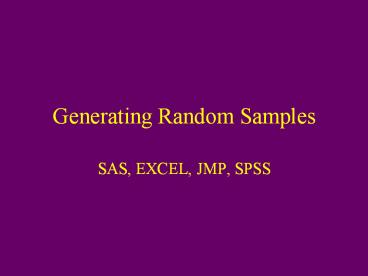Generating Random Samples - PowerPoint PPT Presentation
Title:
Generating Random Samples
Description:
Generating Random Samples SAS, EXCEL, JMP, SPSS Population of Data Sample Data should be in a dataset where each row represents an individual unit, and column fields ... – PowerPoint PPT presentation
Number of Views:35
Avg rating:3.0/5.0
Title: Generating Random Samples
1
Generating Random Samples
- SAS, EXCEL, JMP, SPSS
2
Population of Data ? Sample
- Data should be in a dataset where each row
represents an individual unit, and column fields
represent variables measured on the individual - A new column field will be created that contains
a pseudo-random number generated by statistal
software package (usually Uniform(0,1) r.v.) - Data are sorted by the random number, or simply
selected for analysis (depending on software)
3
All ATL/HNL 10/2004 Delta Flights (N31)
4
SAS Code to Generate Random Sample (n10)
Data Pop Input Day FlightNum TailNum DestCity
TaxiTime Sched Actual Distance RanxRanuni(seed
) / Put in a number where seed is
/ Cards 1 317 N834MH HNL 29 580 567 4496 31 31
7 N840MH HNL 16 580 576 4496 Proc Sort By
Ranx Data Sample Set Pop If _N_ lt
10 Run / You can run any procedures now on
the Sample /
5
Generating Random Samples in EXCEL
- In a new column past the data, type in the first
row containing data on a unit RAND() - COPY and PASTE that cell until all N units have a
random number - While that range of N cells is still highlighted,
click on COPY ? EDIT ? PASTE SPECIAL ? Click on
VALUES (This changes them from Dynamic to
Static) - Place Cursor in Data Field, Click on DATA ? SORT
? Choose Column with Random Values and Choose
appropriate Header Row Status - After data are sorted, COPY and PASTE (SPECIAL
VALUES) the first n units to a new worksheet
6
Random Numbers (Not Sorted Yet)
7
Data Sorted By Random Number
8
EXCEL Random Sample (n10)
9
Random Samples in JMP
- Import Data into JMP
- Click on TABLES ? SUBSET ? RANDOM SAMPLE ? Enter
Your Sample Size (e.g. 10) in Box - Subset Dataset Appears in New Table
- Analyze the Data in that Table
10
Random Samples in SPSS
- Import Data into SPSS
- Older Versions Click Transform ? Random Seed ?
Enter a numeric seed - Newer Versions Click Transform ? Random
Generators ? Active Generator Initialization ?
Fixed Value ? Enter a numeric seed - Click Data ? Select Cases
- Under Select, choose Random Sample of Cases.
Click on Sample box. - Choose Exactly n (10) of the first N (31), click
Continue - Click OK. Slashes will appear in the case numbers
of the cases not in the sample, and an indicator
variable representing Filter will be attached to
end of dataset. - Analyze the Data

